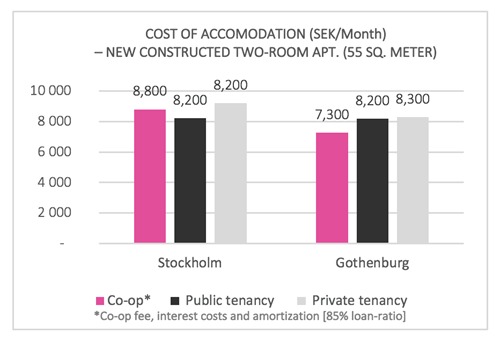During 2019, the Swedish National Board of Housing, Building and Planning (Boverket) estimates an initiated construction of new housing of over 7,000 and 6,000 homes in Stockholm and Gothenburg, respectively. But does enough households have the solvency for the newly constructed apartments?

In Stockholm and Gothenburg, the rate of construction has accelerated in recent years. Meanwhile, both of the municipalities state that there is a long-term deficit in housing, according to Boverket’s latest report on the Swedish housing market. The question is whether there is sufficient demand for these newly constructed apartments from households with the necessary solvency? To analyze this, Croisette presents the average compiled costs for a newly constructed two-room apartment as a co-op and as a public-, as well as a private tenancy. The monthly cost is then set in relation to the households that are considered probable consumers, in this case single- and two-person households, both with and without children. The housing expenses of these types of households vary, according to SCB mainly between 20 and 30 per cent of gross annual income.

For a newly constructed two-room apartment in Stockholm, the monthly expense varies between 8,200 and 9,200 SEK, depending on whether the residence is a private- or public tenancy or a co-op apartment. For the equivalent apartment in Gothenburg, the monthly expense varies between 7,300 and 8,300 SEK. The difference in building costs between the two cities mainly consists of the cost of land associated with new construction. In 2016 the average cost of land in Stockholm amounted to just over 16,000 SEK per square meter apartment area. In Gothenburg the cost of land amounted to approximately 11,000 SEK. The actual construction costs were also slightly higher in Stockholm, mainly due to a higher rate of densification projects, with a higher average construction cost as a result. Croisette assesses the abovementioned types of households generally do not have the sufficient solvency for these newly produced, and often smaller-sized apartments. When comparing the average household solvency with the cost of housing, the disparity is quite substantial.

Although the gross income is generally higher in Stockholm compared to Gothenburg, a large proportion of households in both cities do not posses the necessary solvency. Generally speaking, a household needs two incomes, or one income in the upper range, for a newly constructed apartment. The type of household with the largest difference between solvency and potential accommodation costs is, unexpectedly, households consisting of single people without children. The single households are usually also referred to as those who have the greatest difficulty in entering the housing market. It is also important to keep in mind that new housing is often built in more peripheral urban areas, with a generally larger share of households with low solvency. In these peripheral areas there is an even greater difference between the solvency and cost of accommodation.
How then should residential developers act in the future, in order to take the low solvency into account for newly constructed apartments? To ensure that there is sufficient solvency among consumers for future projects, housing developers could, for example, produce a larger proportion of apartments of larger sizes for which there are more existing consumers with a high solvency. One of the challenges however is to attract households with higher solvency to choose a large apartment instead of acquiring a small property in the same area. Development of smaller individual properties in outer- but high solvency urban areas, is a strategy that has been adopted by several developers. In the longer term, however, this procedure is not a particularly effective way of exploiting land in rapidly growing urban areas. Regardless, it will be very interesting to see how residential developers onward will act in order to match newly produced housing with the actual levels of solvency amongst consumers.




